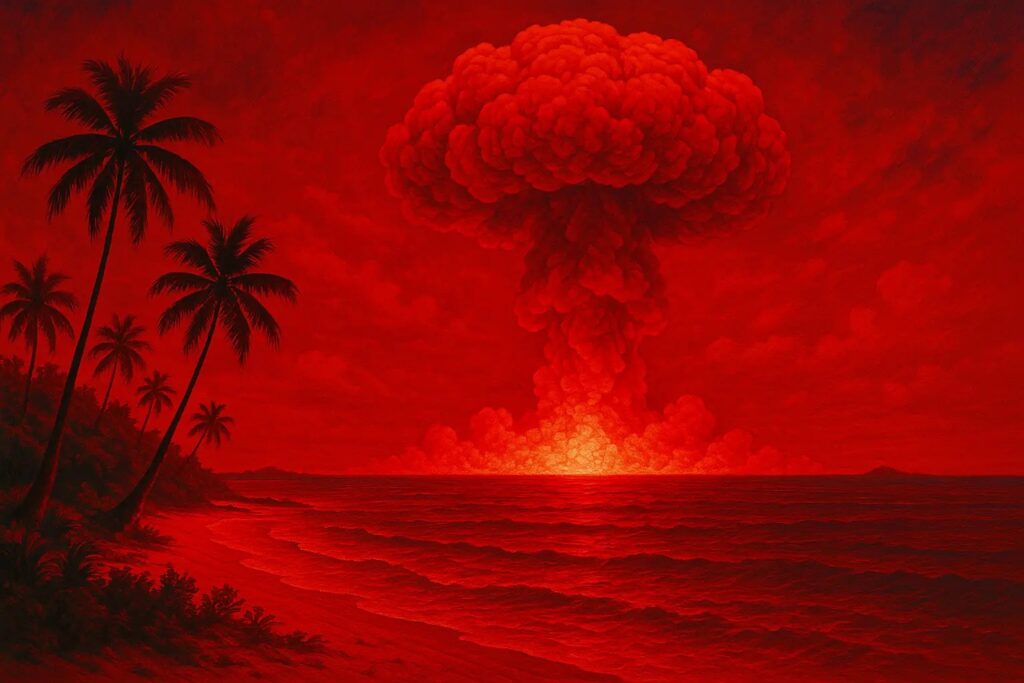US Nuclear Testing: A Glimpse of Paradise—Turned Ground Zero
Imagine waking each morning surrounded by turquoise waters, swaying palm trees, and skies so clear they seem like heaven. That was life in the Marshall Islands—until the sky itself exploded.
Between 1946 and 1958, this remote Pacific paradise was transformed into a radioactive test ground by the United States, forever altering the fate of its people and their land. While the world moved on, the people of the Marshall Islands were left to deal with radiation scars—on their bodies, their homes, and their souls.
This is not just a historical event. It’s an unresolved tragedy.
The Beginning of a Nuclear Nightmare
From War to Weaponry—America’s Post-WWII Gamble
When World War II ended, the world was bracing for peace. But the United States had other plans—testing its terrifying new power: the atomic bomb. With Japan already devastated by Hiroshima and Nagasaki, the U.S. turned its gaze to an isolated region far from mainland eyes—the Marshall Islands.
In 1946, the U.S. selected Bikini Atoll for its first series of post-war nuclear tests, naming the operation “Crossroads.” The goal was clear: showcase and study the power of nuclear weapons. What wasn’t studied enough? The long-term suffering of the people who once called those atolls home.
The Bombs That Shook Heaven
Operation Castle and the Day Hell Fell From the Sky
In March 1954, the U.S. detonated its most powerful hydrogen bomb ever—code-named “Castle Bravo.” Expected to yield 5 megatons, it unleashed 15. The fireball lit the skies, vaporized coral, and sent radioactive ash raining across dozens of islands.
The fallout didn’t just poison the soil. It settled on the skin of children, entered the drinking water, and cursed generations unborn. The people of Rongelap, living over 100 miles away, thought it was snow. They played in it. Hours later, their skin burned. Their hair fell out.
The government’s response? Delayed, dismissive, and woefully inadequate.
The Human Cost of “Progress”
Broken Bodies, Lost Homelands
Over the 12 years of U.S. nuclear testing, 67 nuclear bombs were detonated in the Marshall Islands—equivalent to 1.6 Hiroshima-sized explosions every single day for over a decade.
The Marshallese people were forced to relocate multiple times—often to areas with limited food, water, or medical care. Diseases like cancer and birth defects began to rise. Women reported giving birth to “jellyfish babies”—lifeless, limbless forms that doctors couldn’t explain.
Yet for years, the U.S. government downplayed the crisis. Radiation levels were “safe,” they said. But the graveyards said otherwise.
A Silence That Still Echoes
Where Is Justice for the Marshallese?
In 1986, the United States and the Marshall Islands signed the Compact of Free Association. It offered compensation—but not enough to restore what was lost. Some islands remain uninhabitable to this day. Others have soil that won’t grow food without risk. The people were left with chronic illness, trauma, and broken trust.
The U.S. set up a nuclear claims tribunal that eventually ran out of money. Thousands of cases remain unresolved. Promises were made, but not kept. Medical help? Minimal. Environmental cleanup? Incomplete. Full recognition? Still lacking.
The world calls it the “Atomic Age.” But for the Marshallese, it was an age of betrayal.
Environmental Time Bomb—Still Ticking
Runit Dome: A Nuclear Coffin at Sea
On Runit Island lies a massive concrete dome, built to contain radioactive waste from the tests. Known as the “Runit Dome,” it holds over 100,000 cubic yards of contaminated soil. But the dome is cracking. Rising sea levels threaten to wash radioactive material into the ocean.
The Marshallese fear it will collapse. The U.S. says it’s stable. But who do you believe when trust has already been shattered?
This isn’t just an island issue—it’s a global environmental threat waiting to explode again.
America’s Hidden War
The Test That Wasn’t Just a Test
What happened in the Marshall Islands wasn’t simply scientific research. It was a geopolitical show of strength during the Cold War, using human lives as collateral. Many of the test names—“Bravo,” “Romeo,” “Baker”—sounded harmless. But their effects were anything but.
Military personnel stationed there were also exposed. Many veterans later reported health issues but were denied adequate healthcare or compensation.
The radioactive legacy didn’t just end at the blast zone—it traveled with the wind, with the soldiers, with the silence.
Voices Rising from the Ashes
A New Generation Demands Truth
Today, the children and grandchildren of survivors are reclaiming their voice. They are pushing for justice, for awareness, for healing. Some have taken their stories to the United Nations. Others are documenting their family histories to prevent the world from forgetting.
Marshallese activists argue that nuclear colonialism is real—and ongoing. While superpowers flexed their muscles, their people were left behind to bury the dead and clean up the mess.
This is more than history. It’s happening still—in policy, in silence, in soil that glows.
What Must Happen Now
Real Help, Not Hollow Words
The world owes the Marshallese more than apologies. It owes them:
- Comprehensive healthcare for radiation victims and their descendants
- Full financial compensation for loss of land, homes, and lives
- Environmental restoration and international oversight of radioactive zones
- Truth-telling in history books—not just footnotes and disclaimers
Until then, the bombs are still exploding—quietly, invisibly, in the DNA of the people who survived.
Conclusion: A Legacy Buried in Sand and Ash
The Marshall Islands were once a vision of untouched beauty. But beneath their lagoons lies a dark chapter of American power unchecked.
The world may have forgotten the names of the tests—Castle Bravo, Ivy Mike, Operation Crossroads—but the people of the islands remember every flash, every burn, every child lost.
They are not just test sites. They are tombstones. They are warning signs.

